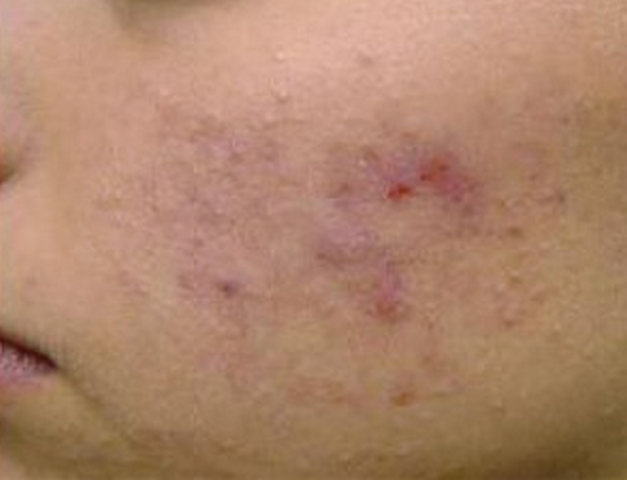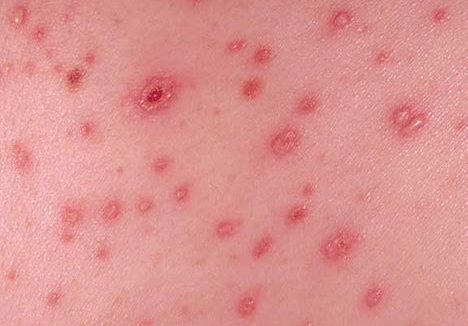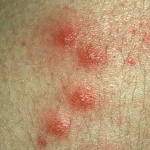Chicken pox is a viral infection that results in formation of blister-like, itchy rashes. It is highly contagious in individuals who have never been affected by the disease and/or not been vaccinated against it.
Chicken pox is normally a mild disease that does not require any medical treatment. It disappears on its own after it has run its course. People at increased risk to developing Chicken pox complications may require hospitalization and medical care. One of best ways to avoid the disease and prevent chicken pox scars is by getting vaccinated against it. The vaccine is safe as well as effective.
Treatment of normal chicken pox symptoms
The below listed self-care guidelines may be followed to alleviate the symptoms accompanying uncomplicated instances of Chicken pox. It will also help decrease the risk to Chicken pox scars development.
- Avoid scratching as it can slow down the healing process, cause scarring, and increase the susceptibility to infection of the sores. Parents can cut the fingernails of affected children and make them wear gloves, especially when sleeping.
- Itchiness and other symptoms can be alleviated via cool baths in a solution of colloidal or uncooked oatmeal and baking soda, and/or use of pain medications, antihistamines, and calamine lotion.
- Apply chamomile lotion or vinegar on the affected skin areas to ease and prevent itchiness.
- People with oral Chicken pox sores can avoid aggravation by consuming a bland, soft diet
- Do not take aspirin as it can cause the deadly Reye’s syndrome
- The skin will remain free from bacteria by application of sandalwood oil.
- Wear loose clothes made from porous fabrics. It will allow the skin to breathe and prevent itching.
Treatment of Chicken pox scars
Chicken pox scars eventually disappear on their own, but can however persist for a long time. People can use the below listed ways to remove chicken pox scars at home or via medical treatments.
Home remedies
- Application of vitamin E oil on the skin. It help the healing process and also nourishes the skin. Continue its use two times a day till the Chicken pox scars disappear.
- Rub a freshly cut lemon across the scars. It will give the skin a healthy glow and also help remove the dead skin cells. Lemon juice also has bleaching properties which can help lighten the Chicken pox scars. Do not venture out into sunlight for about 30 minutes after using this home remedy.
- Consume foods that are rich in vitamin K. This vitamin helps protect and heal the skin. Some food items that have high vitamin K content include spinach, green cabbage, tomatoes, broccoli, green turnips, liver, dairy products, and lean meats.
- Chicken pox scars will also naturally fade away when you intake plenty of water. Intake of at least 80 oz. of water on a daily basis will help increase circulation as well as enhance collagen production which in turn aids in attaining an even and firm skin. Such a skin tone will make the unsightly scars less noticeable.
- Massaging Aloe Vera juice or cocoa butter onto the affected skin areas, multiple times a day, will prevent the Chicken pox scars from darkening.
- Patients can also use OTC scar removal creams to soften and lighten the Chicken pox scars. The effects of scarring can be restricted via use of silicone based creams and gels.
If the above listed home remedies do not help in resolving the problem of Chicken pox scars, then patients should look for medical alternatives. It may be noted that older scars are more difficult to remove as compared to newer scars. Affected individuals should consult a dermatologist or a certified skin specialist to get information about the varied clinical treatment options. You may choose between non-invasive and invasive procedures. Depending on the intensity of Chicken pox scars, some may work better than other treatment procedures.
Medical treatment procedures
A few clinical treatment options for removal of Chicken pox scars are as follows:
- Photo facials:This procedure involves the use of laser beams to revitalize and rejuvenate the skin from within. The laser light breaks down the pigments which cause the discolored Chicken pox scars, while simultaneously enhancing the growth of collagen in the deeper skin layers, thereby helping the outer skin layers to become more even. It is a preferred treatment for more intense and deeper Chicken pox scars.
- Microdermabrasion: It is a non-invasive procedure involving the use of a handheld device with a rapidly spinning wire brush that blows crystals onto the affected skin areas. These crystals gently abrade or ‘polish’ the skin. The abraded skin cells and crystals are then removed via a vacuum tube. This therapy does not injure the skin and its effects are subtle. It is used for treating mild cases of Chicken pox scars.
- Surgical excision:If the non-invasive medical procedure do not help remove the Chicken pox scars, then a more direct surgical route needs to be taken. In surgical excision the affected skin areas are physically cut out. Skin grafts and/or stitches are then used to fill up the holes that result from the procedure.
Chicken pox scar pictures




